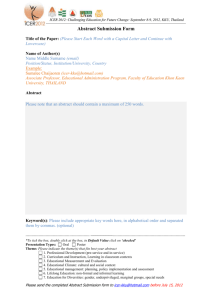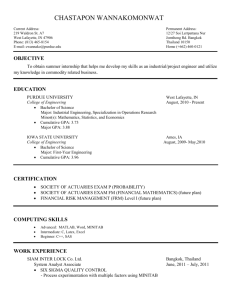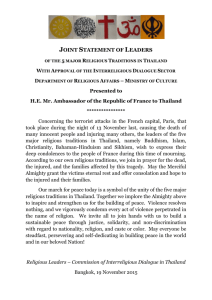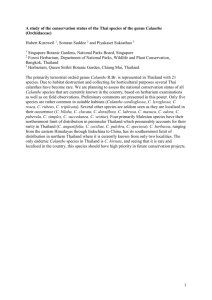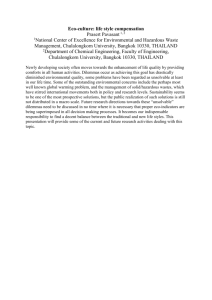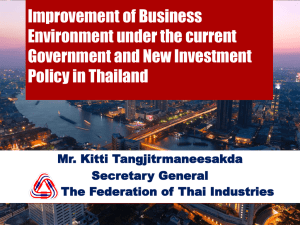Overview
advertisement
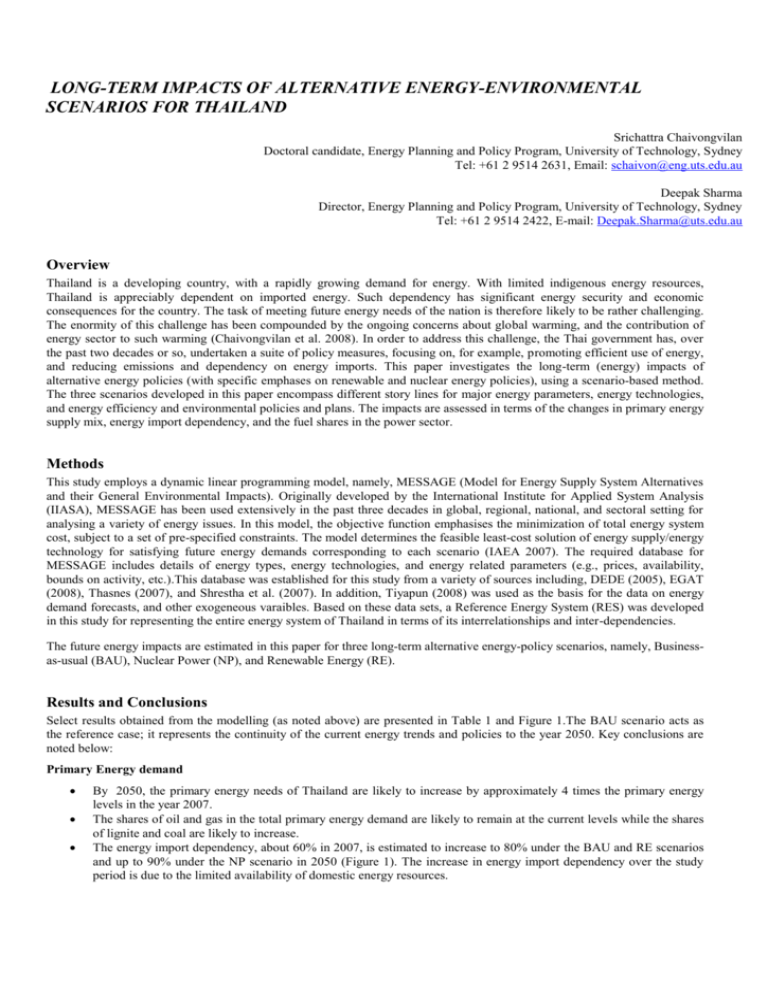
LONG-TERM IMPACTS OF ALTERNATIVE ENERGY-ENVIRONMENTAL SCENARIOS FOR THAILAND Srichattra Chaivongvilan Doctoral candidate, Energy Planning and Policy Program, University of Technology, Sydney Tel: +61 2 9514 2631, Email: schaivon@eng.uts.edu.au Deepak Sharma Director, Energy Planning and Policy Program, University of Technology, Sydney Tel: +61 2 9514 2422, E-mail: Deepak.Sharma@uts.edu.au Overview Thailand is a developing country, with a rapidly growing demand for energy. With limited indigenous energy resources, Thailand is appreciably dependent on imported energy. Such dependency has significant energy security and economic consequences for the country. The task of meeting future energy needs of the nation is therefore likely to be rather challenging. The enormity of this challenge has been compounded by the ongoing concerns about global warming, and the contribution of energy sector to such warming (Chaivongvilan et al. 2008). In order to address this challenge, the Thai government has, over the past two decades or so, undertaken a suite of policy measures, focusing on, for example, promoting efficient use of energy, and reducing emissions and dependency on energy imports. This paper investigates the long-term (energy) impacts of alternative energy policies (with specific emphases on renewable and nuclear energy policies), using a scenario-based method. The three scenarios developed in this paper encompass different story lines for major energy parameters, energy technologies, and energy efficiency and environmental policies and plans. The impacts are assessed in terms of the changes in primary energy supply mix, energy import dependency, and the fuel shares in the power sector. Methods This study employs a dynamic linear programming model, namely, MESSAGE (Model for Energy Supply System Alternatives and their General Environmental Impacts). Originally developed by the International Institute for Applied System Analysis (IIASA), MESSAGE has been used extensively in the past three decades in global, regional, national, and sectoral setting for analysing a variety of energy issues. In this model, the objective function emphasises the minimization of total energy system cost, subject to a set of pre-specified constraints. The model determines the feasible least-cost solution of energy supply/energy technology for satisfying future energy demands corresponding to each scenario (IAEA 2007). The required database for MESSAGE includes details of energy types, energy technologies, and energy related parameters (e.g., prices, availability, bounds on activity, etc.).This database was established for this study from a variety of sources including, DEDE (2005), EGAT (2008), Thasnes (2007), and Shrestha et al. (2007). In addition, Tiyapun (2008) was used as the basis for the data on energy demand forecasts, and other exogeneous varaibles. Based on these data sets, a Reference Energy System (RES) was developed in this study for representing the entire energy system of Thailand in terms of its interrelationships and inter-dependencies. The future energy impacts are estimated in this paper for three long-term alternative energy-policy scenarios, namely, Businessas-usual (BAU), Nuclear Power (NP), and Renewable Energy (RE). Results and Conclusions Select results obtained from the modelling (as noted above) are presented in Table 1 and Figure 1.The BAU scenario acts as the reference case; it represents the continuity of the current energy trends and policies to the year 2050. Key conclusions are noted below: Primary Energy demand By 2050, the primary energy needs of Thailand are likely to increase by approximately 4 times the primary energy levels in the year 2007. The shares of oil and gas in the total primary energy demand are likely to remain at the current levels while the shares of lignite and coal are likely to increase. The energy import dependency, about 60% in 2007, is estimated to increase to 80% under the BAU and RE scenarios and up to 90% under the NP scenario in 2050 (Figure 1). The increase in energy import dependency over the study period is due to the limited availability of domestic energy resources. Table 1 – Primary energy requirements (PJ) 2007 Coal Oil Gas Othersa N&Rb Uraniumc Total a 574 2120 1309 54 490 0 4548 BAU 2010 872 3658 1438 48 496 0 6512 2030 1721 4921 2284 49 606 0 9580 2050 3834 8111 5283 17 739 0 17984 Others include hydro, solar, wind, and geothermal New and Renewable energy (non-commercial) c Uranium import b NP 2010 822 3658 1438 48 496 0 6462 2030 1544 5167 1982 49 606 132 9480 2050 2712 8510 3089 17 739 258 15326 RE 2010 728 2860 1438 49 509 0 5584 2030 1514 3082 2016 50 685 0 7347 2050 2756 4175 3176 19 923 0 11049 BAU: Business-As-Usual Scenario NP: Nuclear Power Scenario RE: Renewable Energy Scenario Figure 1 – Energy import dependency (%) Electricity In the BAU scenario, the country’s electricity demand is projected to increase annually by 3%, from 141 TWh in 2007 to 371 TWh in 2050. Natural gas is likely to maintain its dominant share in electricity generation mix, accounting for nearly 73% of the total generation in 2050. The share of hydro is expected to decrease to 1% in 2050, while the share of other renewable energy is likely to increase to 3% over this time period. Concluding Comment This paper compares the BAU results with NP and RE outcomes. This comparison provides useful insights into the energy dynamics of Thailand. Of particular note are the potential tradeoffs that the Thai policy makers will need to mediate as they endeavour to develop policies to redress energy-environmental challenges. The analyses presented in this paper provide valuable inputs for the estimation of economy-wide impacts of alternative energy-environmental settings. References Chaivongvilan, S., Sharma, D., & Sandu, S. (2008) Energy challenges for Thailand: An overview, GMSARN International Journal, 2, 53-60. IAEA (2007) MESSAGE User Manual, International Atomic of Energy Agency, Vienna, Austria. DEDE (2005) Annual report: Thailand’s Energy Situation 2005, Department of Alternative Energy Development and Efficiency, Bangkok, Thailand. EGAT (2008) Thailand’s Electricity Load Region 2005, System Control and Operation Division, Electricity Generating Authority of Thailand, Bangkok, Thailand. Thasnes, T. (2007) The role of nuclear power and renewable energy technologies in the long-term energy system development of Thailand, Thesis (M. Eng), Asian Institute of Technology, Bangkok, Thailand. Shrestha, R. M., Malla, S. & Liyanage, M. H. (2007) Scenario-based analyses of energy system development and its environmental implications in Thailand. Energy Policy, 35, 3179-3193. Tiyapun, K. (2008) Thailand’s Energy Demand Analysis, Thailand Institute of Nuclear Technology, Bangkok.
